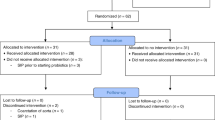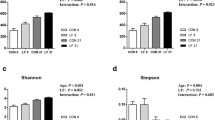Abstract
Probiotics and lactoferrin are currently being used in neonatal intensive care units in the hopes of reducing rates of sepsis and necrotizing enterocolitis (NEC). While studies have shown that these measures can be clinically beneficial to premature babies, and there are ongoing trials to measure their impact on NEC and sepsis rates, little is known about how they may impact microbiota development. We thus employed a newborn piglet model to assess the impact of feeding probiotics or a combination of probiotics and lactoferrin on development of the gastrointestinal microbiota. Healthy full-term piglets were fed either probiotics alone or probiotics and a bovine lactoferrin supplement over the first weeks of life, and their microbiota profiles were compared with unsupplemented controls. We found that both probiotic and probiotic plus lactoferrin treatments impacted the microbial composition within the gastrointestinal tract, with differing impacts on various regions within the gut. In addition, the impact of probiotics was often reversed by the presence of lactoferrin and both feeding interventions altered the microbiota’s genetic propensity to use ferric versus ferrous ions. These results suggest that iron availability may be a key factor to consider when designing feeding interventions that target the microbiome.





Similar content being viewed by others
References
Assa A et al (2016) Mucosa-associated ileal microbiota in new-onset pediatric crohn’s disease. Inflamm Bowel Dis 22:1533–1539. https://doi.org/10.1097/MIB.0000000000000776
Bates D, Machler M, Bolker BM, Walker SC (2015) Fitting linear mixed-effects models using lme4. J Stat Softw 67:1–48
Baveye S, Elass E, Mazurier J, Spik G, Legrand D (1999) Lactoferrin: a multifunctional glycoprotein involved in the modulation of the inflammatory process. Clin Chem Lab Med 37:281–286. https://doi.org/10.1515/cclm.1999.049
Butcher J et al (2018) Independent of birth mode or gestational age, very-low-birth-weight infants fed their mothers’ milk rapidly develop personalized microbiotas low in bifidobacterium. J Nutr 148:326–335. https://doi.org/10.1093/jn/nxx071
Duncan SH, Louis P, Flint HJ (2004) Lactate-utilizing bacteria, isolated from human feces, that produce butyrate as a major fermentation product. Appl Environ Microbiol 70:5810–5817. https://doi.org/10.1128/aem.70.10.5810-5817.2004
Embleton ND, Berrington JE, McGuire W, Stewart CJ, Cummings SP (2013) Lactoferrin: antimicrobial activity and therapeutic potential. Semin Fetal Neonatal Med 18(3):143–149. https://doi.org/10.1016/j.siny.2013.02.001
Fitzgibbons SC et al (2009) Mortality of necrotizing enterocolitis expressed by birth weight categories. J Pediatr Surg 44:1072–1075 discussion 1075–1076
Gevers D et al (2014) The treatment-naive microbiome in new-onset Crohn’s disease. Cell Host Microbe 15:382–392. https://doi.org/10.1016/j.chom.2014.02.005
Glymenaki M, Singh G, Brass A, Warhurst G, McBain AJ, Else KJ, Cruickshank SM (2017) Compositional changes in the gut mucus microbiota precede the onset of colitis-induced inflammation. Inflamm Bowel Dis 23:912–922. https://doi.org/10.1097/MIB.0000000000001118
Guilloteau P, Zabielski R, Hammon HM, Metges CC (2010) Nutritional programming of gastrointestinal tract development. Is the pig a good model for man? Nutr Res Rev 23:4–22. https://doi.org/10.1017/S0954422410000077
Heinsen FA et al (2015) Dynamic changes of the luminal and mucosa-associated gut microbiota during and after antibiotic therapy with paromomycin. Gut Microbes 6:243–254. https://doi.org/10.1080/19490976.2015.1062959
Himmel ME, Yao Y, Orban PC, Steiner TS, Levings MK (2012) Regulatory T-cell therapy for inflammatory bowel disease: more questions than answers. Immunology 136:115–122. https://doi.org/10.1111/j.1365-2567.2012.03572.x
Hornik CP et al (2012) Early and late onset sepsis in very-low-birth-weight infants from a large group of neonatal intensive care units. Early Hum Dev 88(Suppl 2):S69–74. https://doi.org/10.1016/S0378-3782(12)70019-1
Huse SM et al (2014) Comparison of brush and biopsy sampling methods of the ileal pouch for assessment of mucosa-associated microbiota of human subjects. Microbiome 2:5. https://doi.org/10.1186/2049-2618-2-5
Janvier A, Malo J, Barrington KJ (2014) Cohort study of probiotics in a North American neonatal intensive care unit. J Pediatr 164:980–985. https://doi.org/10.1016/j.jpeds.2013.11.025
Jia W et al (2010) Is the abundance of Faecalibacterium prausnitzii relevant to Crohn’s disease? FEMS Microbiol Lett 310:138–144. https://doi.org/10.1111/j.1574-6968.2010.02057.x
Kaufman D, Fairchild KD (2004) Clinical microbiology of bacterial and fungal sepsis in very-low-birth-weight infants. Clin Microbiol Rev 17:638–680. https://doi.org/10.1128/cmr.17.3.638-680.2004
Kim D et al (2017) Optimizing methods and dodging pitfalls in microbiome research. Microbiome 5:52. https://doi.org/10.1186/s40168-017-0267-5
Kisidayova S et al (2009) Effects of high- and low-fiber diets on fecal fermentation and fecal microbial populations of captive chimpanzees. Am J Primatol 71:548–557. https://doi.org/10.1002/ajp.20687
Langille MG et al (2013) Predictive functional profiling of microbial communities using 16S rRNA marker gene sequences. Nat Biotechnol 31:814–821. https://doi.org/10.1038/nbt.2676
Laursen MF, Andersen LB, Michaelsen KF, Molgaard C, Trolle E, Bahl MI, Licht TR (2016) Infant gut microbiota development is driven by transition to family foods independent of maternal obesity. MSphere. https://doi.org/10.1128/msphere.00069-15
Lavelle A et al (2015) Spatial variation of the colonic microbiota in patients with ulcerative colitis and control volunteers. Gut. https://doi.org/10.1136/gutjnl-2014-307873
Legrand D, Elass E, Carpentier M, Mazurier J (2005) Lactoferrin: a modulator of immune and inflammatory responses. Cell Mol Life Sci 62:2549–2559. https://doi.org/10.1007/s00018-005-5370-2
Lopez-Siles M et al (2015) Mucosa-associated Faecalibacterium prausnitzii phylotype richness is reduced in patients with inflammatory bowel disease. Appl Environ Microbiol 81:7582–7592. https://doi.org/10.1128/AEM.02006-15
Louis P, Flint HJ (2009) Diversity, metabolism and microbial ecology of butyrate-producing bacteria from the human large intestine. FEMS Microbiol Lett 294:1–8. https://doi.org/10.1111/j.1574-6968.2009.01514.x
Mark Welch JL, Hasegawa Y, McNulty NP, Gordon JI, Borisy GG (2017) Spatial organization of a model 15-member human gut microbiota established in gnotobiotic mice. Proc Natl Acad Sci USA 114:E9105–E9114. https://doi.org/10.1073/pnas.1711596114
McMurdie PJ, Holmes S (2013) phyloseq: an R package for reproducible interactive analysis and graphics of microbiome census data. PLoS ONE 8:e61217. https://doi.org/10.1371/journal.pone.0061217
Morgan XC et al (2012) Dysfunction of the intestinal microbiome in inflammatory bowel disease and treatment. Genome Biol 13:R79. https://doi.org/10.1186/gb-2012-13-9-r79
Mottawea W et al (2016) Altered intestinal microbiota-host mitochondria crosstalk in new onset Crohn’s disease. Nat Commun 7:13419. https://doi.org/10.1038/ncomms13419
Mottawea W, Butcher J, Li J, Abujamel T, Manoogian J, Mack D, Stintzi A (2019) The mucosal–luminal interface: an ideal sample to study the mucosa-associated microbiota and the intestinal microbial biogeography. Pediatr Res. https://doi.org/10.1038/s41390-019-0326-7
Neu J, Walker WA (2011) Necrotizing enterocolitis. N Engl J Med 364:255–264. https://doi.org/10.1056/NEJMra1005408
Oksanen J et al. (2016) vegan: Community Ecology Package, Version 2.3-5 edn.,
Packey CD, Sartor RB (2009) Commensal bacteria, traditional and opportunistic pathogens, dysbiosis and bacterial killing in inflammatory bowel diseases. Current Opin Infect Dis 22:292–301. https://doi.org/10.1097/qco.0b013e32832a8a5d
Pammi M, Suresh G (2017) Enteral lactoferrin supplementation for prevention of sepsis and necrotizing enterocolitis in preterm infants. Cochrane Database Syst Rev. https://doi.org/10.1002/14651858.cd007137.pub5
Pannaraj PS et al (2017) Association between breast milk bacterial communities and establishment and development of the infant gut microbiome. JAMA Pediatr 171:647–654. https://doi.org/10.1001/jamapediatrics.2017.0378
Paulson JN, Talukder H, Bravo CH (2017) Longitudinal differential abundance analysis of microbial marker-gene surveys using smoothing splines. BioRxiv. https://doi.org/10.1101/099457
Sinha R et al (2017) Assessment of variation in microbial community amplicon sequencing by the Microbiome Quality Control (MBQC) project consortium. Nat Biotechnol 35:1077–1086. https://doi.org/10.1038/nbt.3981
Sokol H et al (2008) Faecalibacterium prausnitzii is an anti-inflammatory commensal bacterium identified by gut microbiota analysis of Crohn disease patients. Proc Nat Acad Sci USA 105:16731–16736. https://doi.org/10.1073/pnas.0804812105
Tropini C, Earle KA, Huang KC, Sonnenburg JL (2017) The gut microbiome: connecting spatial organization to function. Cell Host Microbe 21:433–442. https://doi.org/10.1016/j.chom.2017.03.010
Turnbaugh PJ, Backhed F, Fulton L, Gordon JI (2008) Diet-induced obesity is linked to marked but reversible alterations in the mouse distal gut microbiome. Cell Host Microbe 3:213–223. https://doi.org/10.1016/j.chom.2008.02.015
Weinberg ED (1997) The Lactobacillus anomaly: total iron abstinence. Perspect Biol Med 40:578–583
Wexler HM (2007) Bacteroides: the good, the bad, and the nitty-gritty. Clin Microbiol Rev 20:593–621. https://doi.org/10.1128/cmr.00008-07
Yasuda K et al (2015) Biogeography of the intestinal mucosal and lumenal microbiome in the rhesus macaque. Cell Host Microbe 17:385–391. https://doi.org/10.1016/j.chom.2015.01.015
Zhang X et al (2018) Metaproteomics reveals associations between microbiome and intestinal extracellular vesicle proteins in pediatric inflammatory bowel disease. Nature Commun 9:2873. https://doi.org/10.1038/s41467-018-05357-4
Acknowledgments
This work was funded by the Government of Canada through Genome Canada and the Ontario Genomics Institute (Grant No. OGI-067 and OGI-149), CIHR grant number GPH-129340, CIHR grant number MOP-114872, CIHR grant number ECD-144627 and the Ontario Ministry of Economic Development and Innovation (REG1-4450). The funders had no role in study design, data collection and analysis, decision to publish, or preparation of the manuscript.
Author information
Authors and Affiliations
Corresponding author
Additional information
Publisher's Note
Springer Nature remains neutral with regard to jurisdictional claims in published maps and institutional affiliations.
Electronic supplementary material
Below is the link to the electronic supplementary material.
10534_2019_195_MOESM1_ESM.pdf
Supplementary material 1—Principal co-ordinate analysis (PCoA) of piglet microbiota profiles (a–c) and sequencing replicates (d–f), along with median distances between sequencing replicates (g–i) using the Bray Curtis dissimilarity (a, d, g), weighted Unifrac (b, e, h) and unweighted Unifrac (c, f, i). The PCoA plots are colored by piglet batch and the sequencing groups within the replicates are denoted by shapes (PDF 449 kb)
10534_2019_195_MOESM2_ESM.pdf
Supplementary material 2—Principal co-ordinate analyses of the piglet intestine microbiota profiles (a–c) and stool microbiota profiles (e–f) using the Bray Curtis dissimilarity (a, d), weighted Unifrac (b, e) and unweighted Unifrac (c, f) colored by either intestine grouping (a–c) or sample date (d–f) with shapes denoting the piglet batch (PDF 257 kb)
10534_2019_195_MOESM3_ESM.pdf
Supplementary material 3—Linear regressions with 95% confidence intervals of species richness (a) and evenness (b) in the stool samples over time with the start of the feeding intervention highlighted with a dotted line (PDF 110 kb)
10534_2019_195_MOESM5_ESM.xlsx
Supplementary material 5—Taxa and KEGG terms identified as being differentially abundant between the three feeding interventions (XLSX 334 kb)
Rights and permissions
About this article
Cite this article
Grzywacz, K., Butcher, J., Romain, G. et al. The impact of probiotics and lactoferrin supplementation on piglet gastrointestinal microbial communities. Biometals 32, 533–543 (2019). https://doi.org/10.1007/s10534-019-00195-3
Received:
Accepted:
Published:
Issue Date:
DOI: https://doi.org/10.1007/s10534-019-00195-3




